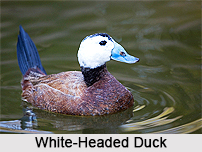 White-Headed Duck is a bird which belongs to the Anatidae family. These birds are distributed in Spain, Asia and North Africa. They are common in Mediterranean, Middle East, south Asia and northwest India. Owing to habitat loss and interbreeding with introduced species, the population of White-Headed Ducks is declining. The ducks have been categorized as endangered species by the International Union for Conservation of Nature (IUCN).
White-Headed Duck is a bird which belongs to the Anatidae family. These birds are distributed in Spain, Asia and North Africa. They are common in Mediterranean, Middle East, south Asia and northwest India. Owing to habitat loss and interbreeding with introduced species, the population of White-Headed Ducks is declining. The ducks have been categorized as endangered species by the International Union for Conservation of Nature (IUCN).
Scientific Name of White-Headed Duck
The scientific name of White-Headed Duck is Oxyura Leucocephala. The term "Oxyura" means pointed tail, while "Leucocephala" means white-headed.
Physical Features of White-Headed Duck
The White-Headed Ducks are medium in size, measuring 45 to 50 cm in length and weighing 500 to 900 grams. Their wingspan is 60 to 70 cm. They have a short neck and the tail is long and is frequently held cocked. The bodies of the adult male ducks are reddish grey in colour while the bodies of the females are greyish brown in colour. The male ducks have bluish broad bill while the females have dark grey bill. The head of the male duck is whitish and there is a black cap on the head. The females have a dark head cap and a dark stripe on the cheek. Both males and females have short, black webbed feet.
Habitat of White-Headed Duck
These ducks prefer to inhabit wetlands that are composed of freshwater or alkaline eutrophic lakes, with plenty of vegetation. They also live in marshes, ponds, and canals. They can dive and swim underwater. The body form of the white-headed duck makes it more dependent on water than other duck species. They are reluctant to fly and prefer to swim for cover.
Breeding of White-Headed Duck
The breeding takes place in the months of summer. Their breeding habitat is large tracts of open water with dense stands of aquatic plants to provide cover and nesting sites.
Diet of White-Headed Duck
The White-Headed Ducks are omnivorous, with vegetable matter predominating. Thus, the primary diet of these ducks comprises of seeds, grains, freshwater vegetation and invertebrates.
Threats to White-Headed Duck
The ducks are considered endangered because of the large reduction in populations in the last ten years. The main reasons of decline are habitat loss, interbreeding with introduced species and hunting.











